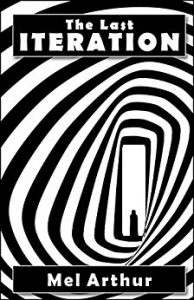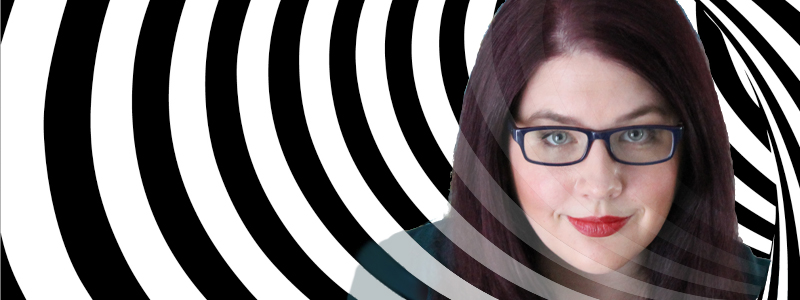 Your new book The Last Iteration is built on the premise of everything that is unknown – everything begins with a white slate. This reminds me of the play No Exit and of course, the more recent Maze Runner. What appealed to you about writing in such a blank space?
Your new book The Last Iteration is built on the premise of everything that is unknown – everything begins with a white slate. This reminds me of the play No Exit and of course, the more recent Maze Runner. What appealed to you about writing in such a blank space?
Setting things in the nearly-blank world of the labyrinth allowed the characters to really take center stage, and they’ve always been what interested me the most about the story. I actually enjoy world-building quite a bit, so I made sure that I knew what the outside world was like, and there are plenty of references to it as the characters carry their baggage into the labyrinth with them, but the story I wanted to tell was about people dealing with people.
 The characters in your book are drawn from a very diverse pool. What character traits were most fun to closet together?
The characters in your book are drawn from a very diverse pool. What character traits were most fun to closet together?
The characters of Hanian and Ciege were always the most fun to write together. They’re such opposites. He’s calm, reserved, and a classic stoic – at least at first impressions. She’s hot-headed and aggressive and throws herself at conflicts without hesitation or forethought. They’re also on opposite sides of a civil war out in the real world, so they’re primed to clash with each other. The characters don’t all start in the same spot in the labyrinth or know who else is there, so I started Hanian and Ciege out alone with none of the other characters to mediate, so they’d have to work together and find their common ground.
And as a follow-up to that question, what type of stressful situations were most interesting to inflict on the characters?
Despite having monsters, shifting terrain, and extreme weather as options to throw at the characters when they needed a challenge, I think the most interesting challenges they face are all based on personality conflicts, because the answers aren’t as easy. Like putting two enemies together and letting them think there’s no one else around to work with, or pairing the most religious character with the biggest skeptic, but letting them share an attraction. I suppose this goes along with focussing on the characters over the setting; the labyrinth and its challenges end up being a backdrop for the human conflicts to play out against.
 You have created a world with a complex and highly symbolic religious framework. How did you use those symbols to add depth to your story?
You have created a world with a complex and highly symbolic religious framework. How did you use those symbols to add depth to your story?
I like the idea of big mythical archetypes, and I’ve always enjoyed stories where you’re given that kind of background and left to figure out which characters fit into which role.The first time I encountered this was probably David Eddings’s Belgariad series. He sets up a mythology that calls for people like the “Man with Two Lives” and the “Mother of the Race that Died,” and then gradually reveals which characters fill those roles during the course of the story. As a reader, I liked trying to guess from the clues he laid out, and I still enjoy that kind of mystery whenever I encounter it in fiction.
I wanted to bring some of that into the Last Iteration, but also to work with how the characters defied their archetypes. As part of the world-building behind the story, I set up a religion that’s loosely based on astrology; there are six signs, all corresponding to constellations in a zodiac. Each of them is supposed to represent certain personality traits or ambitions. The Zealot, for instance, is the sign for politicians and religious leaders, but it’s also the sign for determination and drive, so someone with no political ambition might ‘worship’ under that sign if they feel they need help accomplishing a difficult goal.
Each of the characters is supposed to be an example of one of the signs of the zodiac, and they all check off many of the boxes, but the real exploration of their characters is in the ways they don’t fit. My Tyrant is a hardened soldier, like he’s supposed to be – but he’s also concealing a lot of vulnerability and a need to connect and be understood. My Maid is gentle and naive, but she can be extremely stubborn, and very tough in a crisis.
And of course, there’s the underlying mystery of the labyrinth, and who has decided to cast the zodiac as its inhabitants.
Your bio says you like to paint and draw, what is your favorite style and subject to explore artistically?
That’s probably giving me more credit as an ‘artist’ than is really due. I’m a doodler, and I used to draw a lot when I was younger. It’s a useful skill to have in your back pocket – when my kids ask me to draw a dragon, I can draw something recognizable as a dragon – but I don’t practice it as a craft.
I love looking at impressionist paintings. There’s something about the ability to conjure the image of something ‘real’ by using only swipes and blobs of color that has always really impressed me. I was able to visit the Van Gogh museum in Amsterdam last year and it was amazing to see up close.
What is your favorite (read) book and why?
My favorite book is Terry Pratchett’s Nation, which is a standalone YA book outside of his regular series. That’s not a genre I read often, but it’s a really beautiful story, set in a just-slightly-alternate universe that’s a little more hopeful than ours, so I love going there and would recommend it to anyone.
What is the book you dream of writing and haven’t yet?
This may sound unambitious, but the only book I’ve really wanted to write was The Last Iteration and its sequels.
I’ve been telling myself stories in my head since I was eight years old. I keep a roster of about a dozen that I cycle through when I’m bored or need a distraction, working on the story mentally for a few weeks before I get tired of it and switch to one of the others. For the most part, they don’t really have endings – they just drift to a stop. Each time I visit them, I see if I can get a little further or build out the world a little more. The Last Iteration is the only story that really stuck with me in a lasting way. It took over my inner story space for a couple of years, and I ended up with an entire plot, so it’s the only one I’ve ever really felt compelled to write down.
It’s certainly possible that another story will come along that refuses to go away, and I’ll have to pin it down by writing it out, but I don’t think it’s an idea that I’ve had yet.
Watch her Facebook Live event from November 13.
 More about The Last Iteration
More about The Last Iteration
Find out more about Mel Arthur
Webpage: Mel Arthur

